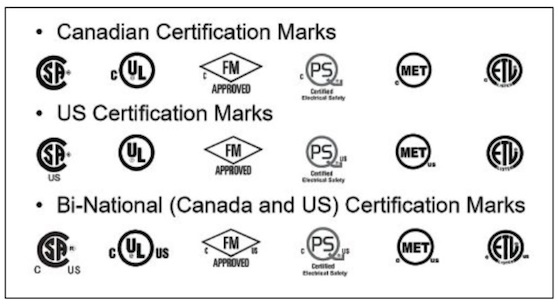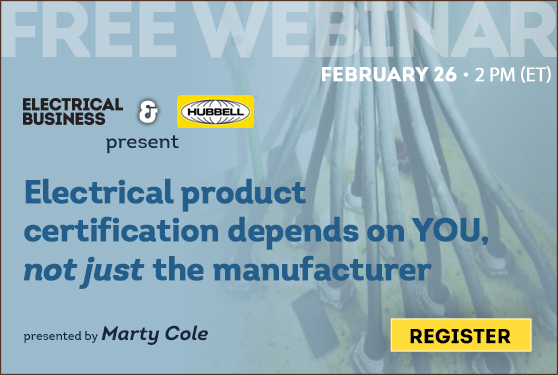
Articles
Features
Codes & Standards
Safety
Incorrect modification of certified products can defeat the equipment protection
May 8, 2020 | By Marty Cole

May 8, 2020 – The Canadian Electrical Code (CE Code) mandates that all products used in the electrical system be certified. In most cases, this means products are tested to Canadian Standards by an accredited third-party testing body (CB). The Standards Council of Canada (SCC) accredits standards development organizations (SDO) to write Canadian standards and CB to approve products to those standards.
There are several types of product certification. The most common involves testing a product to verify it meets standard requirements and if it passes, a certification is issued by the CB. The CB audits manufacturers regularly to verify that product continues to comply. Other types of certification include field evaluation, limited production and batch testing. In rare cases, a standard may not exist, as in the utility industry. If that’s the case, the owner and local regulator agree on a process to ensure the required level of safety.
As proof a product has been tested and certified, the CB issues a “Certificate of Compliance” (CoC) and allows the manufacturer to apply an official mark or logo to the product.
All CoCs include conditions of use that are necessary for compliance to be maintained. This may be as simple as: “must be installed in accordance with the CE Code,” or more complicated, with specific instructions. However, a CoC is an historical document that does not expire and proves the product was built correctly. The manufacturer has no control over what happens afterwards.
If the product is:
• installed following the manufacturers’ instructions and the CE Code, without modifications, there is no change to the CoC.
• installed incorrectly, there may be issues with the CoC.
• modified or altered during installation, there is no way to know if the product remains in compliance with the CoC.
Manufacturers and CBs have no control over the installation, modifications, use or abuse or the environmental conditions where a product is used, so they can’t confirm with certainty that an installed product complies with the CoC.
This is not to suggest an installed product that doesn’t comply with the CoC is unsafe, but if there is an increased risk to persons, property or any “unsafe condition,” then there is a problem.
Take, for example, a 15A 120V U-ground receptacle which can’t be modified. If the receptacle is installed in an outlet box with a cover, both certified and installed according to the CE Code, it complies with the CoC. However, the CoC would be invalidated if the installer accidently reversed the hot and neutral wires, and the device would become a shock hazard that could cause injury or even death.
Products, such as sheet metal or non-metallic electrical enclosures, often require user modifications. This may include the addition of openings for wiring, operators, displays, controls, etc. and mounting internal equipment. Since these modifications are not done by the manufacturer, there is no way to confirm if the enclosure complies with the CoC.
Hazardous location equipment
There are greater risks with hazardous location equipment. Explosion-proof enclosures rely on specific tolerances to prevent an internal explosion from reaching the outer atmosphere. These enclosures are often purchased without any openings and the user customizes them. If a competent machine shop does the work using the correct equipment, there are no major issues. However, users will add wire entries using hand-held drills and thread taps without any gauging, which may create an issue. While reported problems are rare, the manufacturer or CB cannot confirm if a user modified enclosure complies with the CoC without retesting.
If an original manufacturer’s replacement parts are used for maintenance, since the manufacturer didn’t do the work, technically, compliance with the CoC may not actually be confirmed. There is rarely an issue with this for any equipment, since regular maintenance is essential for the safe and efficient operation of a facility.
Maintaining hazardous location equipment is a bit different than ordinary location products. For example, LED replacement lamps or kits are available that may require disconnecting the original components or completely replacing them. While compliance with the original CoC is no longer confirmed, there are no significant issues with non-hazardous location fixtures.
That isn’t true for hazardous location luminaires. Their CoC ensures any heat or spark producing components are measured and controlled (for both external and internal surfaces) and determines which Temperature Code (T-Code) is used. While CFL and LED replacement lamps may run cooler than incandescent or HID, they contain electronic components that could ignite an explosive atmosphere. Most users of hazardous location fixtures may not understand this and simply use the replacement lamps. Not only does this void the CoC, it can create a serious safety issue.
Common mistakes include adding the wrong components to Class I, Division 2 or Zone 2 panels. The internal components determine the rating and not the enclosure. Adding “new” arcing, spark or heat producing components means there is no protection. Not only is compliance with the CoC lost, it would be a serious risk to the user.
Explosion-proof or flame-proof equipment depends on the enclosure for protection. Improperly installed seals are a common problem and several maintenance issues can invalidate the CoC. These include:
• Adding heat-producing components that could alter the T-Code by increasing it to unacceptable, or dangerous, levels.
• Adding high-current interrupting devices. Most enclosures would rupture under the pressures created under fault conditions.
• Field-drilling cable entries require correct procedures; errors could compromise the enclosure integrity.
• Not installing all the enclosure cover bolts.
• Using bolts that are of a different material or strength than the original.
• Applying excessive torque to the bolts could strip the threads and compromise the enclosure integrity.
Any alterations to an explosion-proof or flame-proof enclosure could compromise its integrity, invalidate the CoC and pose a serious safety risk, and what happens after shipment may not comply with the certification.
The CoC requires manufacturers to include installation instructions with the product as well as any operation and maintenance requirements. If the product is installed, modified or maintained correctly, the CoC remains valid.
Regulators and users understand that maintaining 100% CoC compliance is a good idea, but it isn’t always possible. What is important is for the user to identify which of their activities could increase the risk to safety, performance and equipment integrity. For minor issues, even if compliance with CoC is lost, they may choose to carry on the way things have always been done. However, if there is any increased risk to the safety of persons or property, or performance problems are caused, these must be addressed. This may require the involvement of the original manufacturer and/or CB.
The challenge is to understand the difference.
About the author…
Marty Cole has worked for Hubbell Canada for over 40 years and is an IEEE Senior Member, member of the Canadian Electrical Code Part I, (Section 18), chair of the CSA Integrated Committee on Hazardous Location Products, Chair of the Electro Federation Canada’s Wiring Products Section (Sub-section on Hazardous Location Products) and member of Alberta Safety Codes Council, Electrical Sub-Council, among other committees. You can reach him at mcole@hubbell.ca.
This article—along with other great content—appears in the February 2020 edition of Electrical Business Magazine.
Print this page
